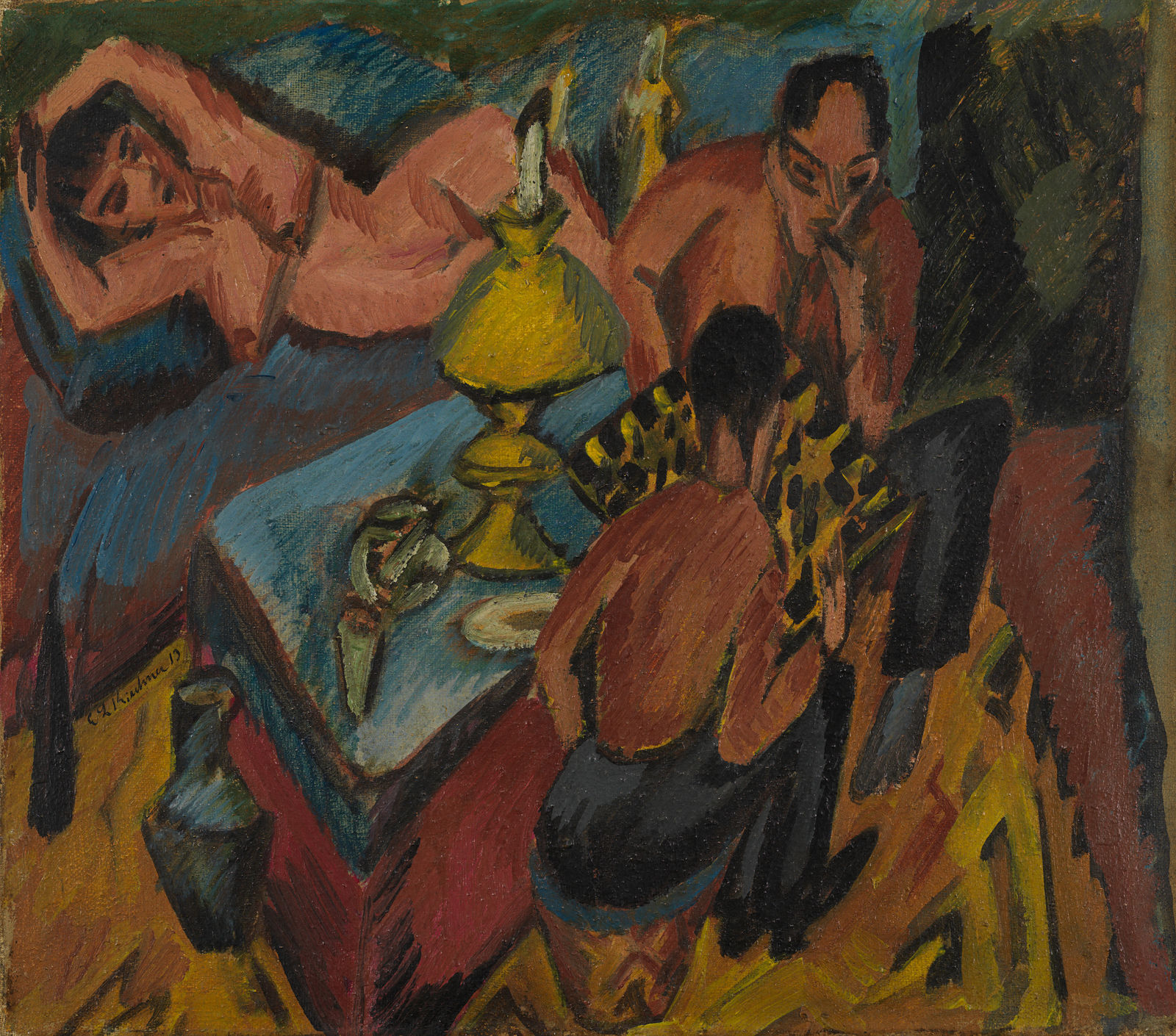This audio walk developed by the artist duo Po:era takes us to six addresses in Friedenau where the Brücke artists lived, as well as their friend, the painter Emma Ritter, and Emy Frisch, Karl Schmidt-Rottluff’s future wife and the photo documentarian of the group. From their perspective, we learn more about the people behind the art of the Brücke and how they challenged the conventions of their era outside of their artistic work.
Across six chapters, Po:era draws on historical facts to tell fictionalised stories that could have occurred at the different locations in one way or another. Based on classic radio play formats, the scenes are embedded in an accompanying narrative that not only contains information about each of the addresses and tips for the walk through Friedenau, but also repeatedly makes links back to the present day and situates the accomplishments of the artists’ group in contemporary discourses.
We recommend completing the audio walk in the suggested order and in one go, which should take approximately 90 minutes. The start point is at Durlacher Straße 15, near Bundesplatz S-Bahn station. The route to each of the next stops is marked on the map, which makes it easier to find your way around if you have location services enabled on your smartphone. Each chapter has photographs to help identify the correct buildings, but they can also be accessed in any order and from the comfort of your own home. Accompanying music at the end of each chapter enhances the walks between the stops and gives listeners a feel for the period when the Brücke artists lived in Berlin. Good-quality headphones will provide the best listening experience.
Live-in studios of Max Pechstein (1909–1912) and Ernst Ludwig Kirchner (1911–1913)
Art school MUIM-Institut (1911–12)
Until 1932: Durlacherstrasse 14, Berlin-Wilmersdorf.
Building partially destroyed in the Second World War, later rebuilt
Today: Durlacherstrasse 15/15a, Berlin-Wilmsersdorf
“My local pub is a little more in line with conventions than the one in Dresden, but there are still some interesting things here, such as the divan with my carved figures and the tea table with 3 pillar figures […].”
Ernst Ludwig Kirchner to the collector Luise Schiefler, March 1912
Art and life merged in the so-called Bieberbau. There was a popular artists’ pub at the front of the building; the garden wing houses several studio spaces. It was the place to indulge in bohemian life: artists work on new projects next door to each other, exchange ideas about art, live and party together.
Max Pechstein was the first Brücke artist to move to Durlacher Straße in 1909. He rented a studio with heating on the second floor for 650 marks a year. Before the other group members followed him from Dresden to the imperial capital in the autumn of 1911, Kirchner and Erich Heckel in particular were drawn to their friend’s place for longer periods. It was Kirchner who was most captivated by life in the Bieberbau, which it’s no surprise that he soon became Pechstein’s studio neighbour.
“Things still weren’t enough in my Berlin existence, not in the slightest. It stayed a life of short commons. At Durlacherstr. 14, where I had my studio next to Scheibe and Marcks, I worked frantically and dulled my hunger by drinking coffee and smoking tobacco.”
Max Pechstein in his Erinnerungen (Memoirs), 1945/46
Together with his partner, the dancer Erna Schilling, he transformed their new home into a Gesamtkunstwerk: the space was decorated with painted walls, embroidered fabrics and furniture he had designed himself. He was inspired by the formal languages used in works from Oceania, Central India and West Africa; his interest was purely aesthetic – there was no attempt to reflect on colonial contexts. Kirchner’s “exoticising gaze” is closely linked to his efforts to distance himself from the rigid conventions of imperial society.
Ernst Ludwig Kirchner, Häusliche Szene (Gewecke und Erna), 1913, Brücke-Museum
Ernst Ludwig Kirchner, Unterhaltung, 1913, Brücke-Museum
When he and Pechstein founded a private art school – the MUIM-Institute (Moderner Unterricht in Malerei or Modern Lessons in Painting) – in the winter of 1911 to help boost their finances, Kirchner’s living and studio space also became a teaching room. Both artists aspired to create a true-to-life alternative to traditional academic training. They tried to draw attention to their venture with specially designed advertisements and posters, but with disappointing results – only two students, Werner Gothein and Hans Gewecke, joined the school. Instead, they caught the eye of the conservative art establishment: Anton von Werner, artist and director of the Royal Academy, had the institute spied on by the police for several months on account of alleged “shameless [teaching] methods”.
“Your Excellency, I believe I may most obediently submit the following leaflet, ‘Prospectus of a new art education institute’, which recently came to my attention. […] All our efforts to educate and train young people in artistic creation and feeling are as useless as they are futile in the face of possibilities such as this Muim-Institut with its shameless cover page and its ‘modern teaching based on observation and experience, also for non-experts’ – for such weeds overgrow and suffocate all healthy life and bring us ever further into decline for the sake of the artistic freedom.”
Anton von Werner, Director of the Royal Academy, to the Prussian Minister of Education, 7 December 1911
This conduct exposes how state institutions at this time massively rejected art that did not conform to traditional expectations. Surveillance was quickly suspended, presumably due to MUIM’s unsuccessful outcome – the institute ended its activities after only one year.
The failure of their joint project was paralleled by Pechstein’s increasing recognition in the Berlin art world. Both these developments put a severe strain on their friendship, and Pechstein left Durlacher Straße in 1912. A year later, when the Brücke disintegrated as a group, Kirchner also moved out.
Valentina Bay













